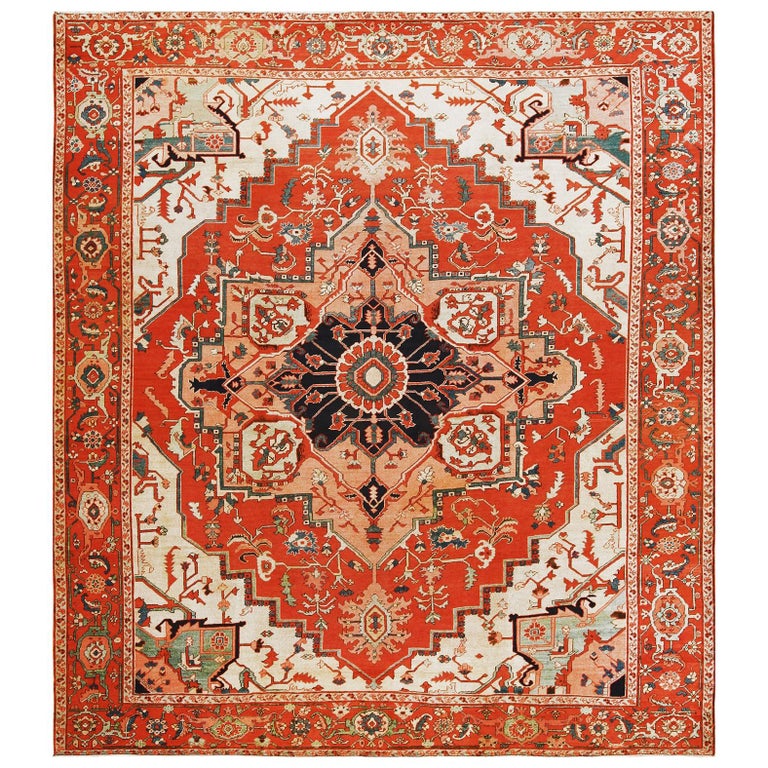
Heriz, Gorevan, Ahar, Kharajeh etc. are ‘Rugs of Sarab, which are [often
classified and known] as Heriz, (/) The usual adjective for “of Sarab” would be “Sarab-i”, this changed to “Serapi”. ‘ (Wikipedia)
‘.. the designs of Serapis were heavily influenced by Tabriz rugs made during the late nineteenth century. ‘ (-) The Origin of Serapi Rugs by Majid Paydar, PhD

Most rugs coming of the county of Sarab would be referred to as Serapi. We shall however find out that in practice, this term applies only to finer quality rugs from the region.
In the later part of the 19th century, and the beginning of the 2oth, rugs from towns of Heriz, Ahar, Gorevan, Karajah, and possibly Bakshaish, were marked as Heriz on the market in Tabriz and on international shipping labels.

Many village rugs produced throughtout the region were labelled as Heriz as well.
It is only later in the 20th century that merchants began to observe differences in design, weave and colour scheme.
Heriz rugs from Heriz town, rugs that Cecil Edwars refers to as ‘proper Heriz rugs’ showed a clear tendency toward geometric form drawn likely on the Caucasian designs. Ahar rugs seemed to continue the curvilinear traditions of the region.
All these rugs however shared a technical structure of weave rarely exceeding 30 KPSI and were known and referred to on the western markets as Heriz rugs.
A significant number of finer rugs however left Serab province (via Tabriz) throughout the most part of the 19th century. They featured a range of designs typical to earlier Heriz and Ahar rugs but differentiated from them structurally; they were all made in no less than 100-110 KPSI.

Most likely, being destined for more demanding buyers, finer materials and better skilled weavers were selected to make these rugs.
The natural process of aging further enhanced the aesthetic differences between the lower and higher end rugs; the latter being known today as Serapi rugs.
Interestingly, as Tschebull argues, coarse village rugs from Heriz literally replaced Kazaks on the western market, and the same ‘coarse Heriz rugs’ replaced finer Serapis from the market in Tabriz and consequently the world.
Economy and fashion have always shaped the rug insdustry around the world, and the rug industry in the Transcaucasus was no exception.
Toward the end of the 19th century, the westerners discovered Caucasian rugs. They appealed to consumers on both sides of the Atlantic.
Rugs from the Caucasus were prediminantly a product of the so-called ‘cottage industry.’
A loom was a permannt fixture in nearly all housholds across the region and women produced small and nedium rugs afforded by the size of the ‘domestic’ loom.
When the market demanded larger carpets with similar course feel and geometric designs, the production shifted to Heriz and the surrounding villages (Tschebull).
Possibly, the demand for simple Heriz rugs was such that the tradition of much finer ‘Serapis’ was abandoned.

As of the second quarted of the 20th century, Serapis were no longer made and the ‘cottage rug industry’ in the Caucasus was already in decline.
It can be said that the middle of the 19th century witnesses the develpment of some of the finest rug traditions both in the Caucasus and Transcaucasus.
Whimsical, undpredicatble in design, rich in colour but rather coarse rugs were produced in towns and villages across the Caucasus.
Rich in colour, complex in design ‘Serapis’ were made in Serab county (Transcaucasus) .
The first were in serious decline as of 1930s, the latter literarily ceased to exists.
Meanwhile, Heriz, Gorevan, Karajeh and Ahar carpets continue to be produced in large numbers and sold London, New Your, Paris, Miland and beyond.
According to Cecil Edwards, ‘upwards of half a million carpets of these types have been woven in the villages of the area.’ (1950s)
The process of mass production in the region brought about changes in production and materials.
Coarse Heriz rugs in 30 KPSI were simply faster to make than much finer ‘Serapis’ , and since they were designed to be substantially less expensive, lower quality wool and chemical dyes were used in their production.
‘Until recent years the weavers of the Heriz area produced their wools or spun yarn from the neighboring Shahsevan tribes. That admirable practice is unhappily fast disappearing. Today the villagers buy their yarn ready spun in the bazzars of Tabriz and Ardebil. (/) The system of dyeing, too, has sadly deteriorated. (/) The blue, red and green are now dyed in Tabriz by the twon dyers, with synthetic dyes.’ (C. Edwards)
A.G.
This article is a continuation of our previous blod Heriz Rugs and the Caucasian Influence
